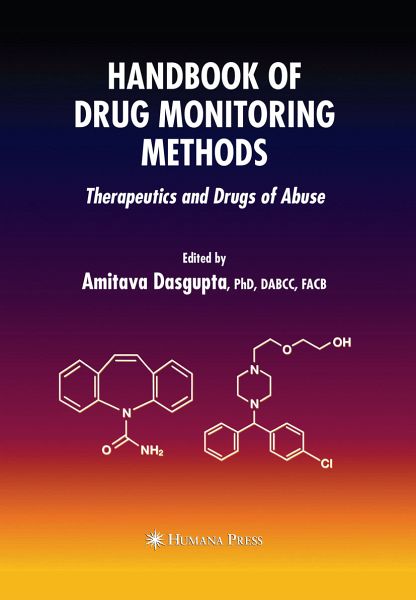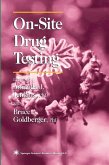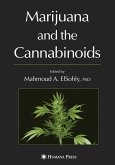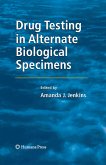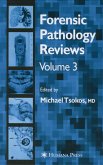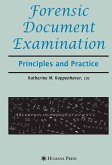In Handbook of Drug Monitoring Methods: Therapeutics and Drug Abuse, authors discuss the different analytical techniques used in today's practice of therapeutic drug monitoring and drugs of abuse as well as alcohol testing with relevant theory, mechanism, and in-depth scientific discussion on each topic. This volume is the perfect handbook and quick reference for any clinical laboratory, allowing clinicians to find the potential source of a false-positive or a false-negative result in the daily operation of a toxicology laboratory. At the same time, this book can also be used as a reference for medical technologists, supervisors, laboratory directors, clinical chemists, toxicologists, and pathologists to find in-depth cause of a potential interference and what tests can be ordered to circumvent such problem. The volume's first half focuses on various issues of therapeutic drug monitoring. Additional chapters cover analysis of heavy metals, alcohol testing, and issues of drugs of abuse testing. These chapters are written by experts in their relative sub-specialties and also by the editor. Comprehensive and timely, Handbook of Drug Monitoring Methods: Therapeutics and Drug Abuse is the ideal text for clinicians and researchers monitoring alcohol and drug testing and other important tasks of toxicological laboratory services.
Dieser Download kann aus rechtlichen Gründen nur mit Rechnungsadresse in A, B, BG, CY, CZ, D, DK, EW, E, FIN, F, GR, HR, H, IRL, I, LT, L, LR, M, NL, PL, P, R, S, SLO, SK ausgeliefert werden.
From the reviews:
"This is a comprehensive handbook on all aspects of drug monitoring. ... This has broad appeal. Of course it would appeal to anyone actively measuring drug levels (i.e., clinical laboratory scientists, toxicologists, clinical chemists). It would also appeal to anyone interested in how such testing is performed and the pitfalls in interpreting results (students or practitioners in any medical discipline or allied health field, poison control centers, concerned parents, etc.). ... This is a very nice addition to the field of drug testing and monitoring." (Valerie L., Doody's Review Service, February, 2008)
"This book addresses the issues of therapeutic drug monitoring but also includes information about drugs of abuse, natural products and toxic elements. ... The volume is an ideal reference for clinical laboratories ... . A sturdy construction, good quality paper, a pleasant layout, the inclusion of graphs and diagrams, as well as chemical structures, copious relevant references and a detailed index make this an extremely useful book. If this is your field then this book should be with you." (Steve Mitchell, International Society for the Study of Xenobiotics Newsletter, Spring, 2008)
"A comprehensive textbook covering the theory and practice of drug analysis as well as the reasons behind the methods, their advantages, pitfalls and even what one does with the measurements after they have been acquired. ... To find a text that not only covers all aspects but flows so well across the disciplines is a real rarity. ... It really is unusual to see theory and practice sitting together so comfortably. Overall a refreshing change to books with similar titles ... ." (Graham Lappin, British Toxicology Society Newsletter, Summer, 2008)
"This book is meant to be 'a handbook at the bench of a clinical laboratory' to serve as a quick reference to find the source of a false positive or a false negative result. ... alsobe useful for various other laboratory personnel including toxicologists and pathologists. ... The book maintains its 'handbook' style throughout with each chapter written in a precise and concise manner using very readable language. ... would be very useful to a variety of medico-legal scientific disciplines including forensic toxicologists." (William Westenbrink, Canadian Society of Forensic Science Journal, August, 2008)
Aus den Rezensionen: "... Die angesprochenen Themen werden ausführlich und in alter gebotenen wissenschaftlichen Tiefe abgehandelt ... Das Buch eignet sich somit hervorragend als Referenz für alle, die auf diesem Gebiet tätig sind. ... Neben einer guten Einleitung, die einen schnellen Überblick über das Gebiet verschafft, finden sich Kapitel zur Verfälschung von Probenmaterial ... Zusammenfassend handelt es sich bei dem vorliegenden Buch um ein interessantes Nachschlagewerk für alle, die sich mit Therapeutischem Drug-Monitoring und/oder dem Nachweis von Drogen beschäftigen ..." (Priv.-Doz. Dr. med. Werner Steimer, in: Laboratoriums-Medizin: journal of laboratory medicine, 2009, Vol. 33, Issue 1, S. 39)
"This is a comprehensive handbook on all aspects of drug monitoring. ... This has broad appeal. Of course it would appeal to anyone actively measuring drug levels (i.e., clinical laboratory scientists, toxicologists, clinical chemists). It would also appeal to anyone interested in how such testing is performed and the pitfalls in interpreting results (students or practitioners in any medical discipline or allied health field, poison control centers, concerned parents, etc.). ... This is a very nice addition to the field of drug testing and monitoring." (Valerie L., Doody's Review Service, February, 2008)
"This book addresses the issues of therapeutic drug monitoring but also includes information about drugs of abuse, natural products and toxic elements. ... The volume is an ideal reference for clinical laboratories ... . A sturdy construction, good quality paper, a pleasant layout, the inclusion of graphs and diagrams, as well as chemical structures, copious relevant references and a detailed index make this an extremely useful book. If this is your field then this book should be with you." (Steve Mitchell, International Society for the Study of Xenobiotics Newsletter, Spring, 2008)
"A comprehensive textbook covering the theory and practice of drug analysis as well as the reasons behind the methods, their advantages, pitfalls and even what one does with the measurements after they have been acquired. ... To find a text that not only covers all aspects but flows so well across the disciplines is a real rarity. ... It really is unusual to see theory and practice sitting together so comfortably. Overall a refreshing change to books with similar titles ... ." (Graham Lappin, British Toxicology Society Newsletter, Summer, 2008)
"This book is meant to be 'a handbook at the bench of a clinical laboratory' to serve as a quick reference to find the source of a false positive or a false negative result. ... alsobe useful for various other laboratory personnel including toxicologists and pathologists. ... The book maintains its 'handbook' style throughout with each chapter written in a precise and concise manner using very readable language. ... would be very useful to a variety of medico-legal scientific disciplines including forensic toxicologists." (William Westenbrink, Canadian Society of Forensic Science Journal, August, 2008)
Aus den Rezensionen: "... Die angesprochenen Themen werden ausführlich und in alter gebotenen wissenschaftlichen Tiefe abgehandelt ... Das Buch eignet sich somit hervorragend als Referenz für alle, die auf diesem Gebiet tätig sind. ... Neben einer guten Einleitung, die einen schnellen Überblick über das Gebiet verschafft, finden sich Kapitel zur Verfälschung von Probenmaterial ... Zusammenfassend handelt es sich bei dem vorliegenden Buch um ein interessantes Nachschlagewerk für alle, die sich mit Therapeutischem Drug-Monitoring und/oder dem Nachweis von Drogen beschäftigen ..." (Priv.-Doz. Dr. med. Werner Steimer, in: Laboratoriums-Medizin: journal of laboratory medicine, 2009, Vol. 33, Issue 1, S. 39)

